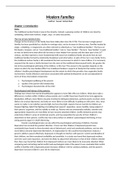Modern Families
Author: Susan Golombok
Chapter 1: Introduction
Intro:
The traditional nuclear family is now in the minority. Instead, a growing number of children are raised by
cohabiting, rather than married-, single-, step-, or same-sex parents.
The rise of new family forms:
Changes to the structure of the family have been takin place since the 1970s. The increase in single-parent
families has been paralleled by a decline in marriage rates, and an increase in divorce rates. Families headed by
single-, cohabiting- or stepparents are often referred to collectively as “non-traditional families”. The focus on
this book is, however, not on “non-traditional families”, but on “new families”. The term “new families” is used
to refer to family forms that either did not exist or were hidden from society until the latter part of the 20 th
century, and that represent a more fundamental shift away from traditional family structures than do non-
traditional families formed by relationship breakdown and reformation. In spite of the rise in new family forms,
the traditional nuclear family is still considered the best environment in which to raise children. It is commonly
assumed that the more a family deviates from the norm of the traditional heterosexual family, the greater the
risk to the psychological well-being of the children. Is this true? The answer to the question depends on the
extent to which the new families differ from traditional families in aspects of family life that matter most for
children’s healthy psychological development and the extent to which they provide a less supportive family
environment. Family influences and factors associated with optimal development can be conceptualized in
terms of three interrelated components:
1. Psychological wellbeing of the parents
2. Quality of the parent-child relationship
3. Psychological characteristics of the child
Psychological well-being of the parents:
Findings have shown that marital dissatisfaction appears to have little effect on children. What does make a
difference is marital conflict. Children whose parents are in conflict have been found to be more aggressive,
disobedient, difficult, more likely to become involved in delinquent behaviour, perform poorly at school, more
likely to be anxious/depressed, and lastly are more likely to have difficulty in getting on with peers. Also, what
seems to matter is not whether parents fight, but how they fight. Aspects that are harmful to children are:
frequent fighting, belief that fighting is heralding their parents’ separation, severe hostility, being subject of
their parents’ argument, and the inability to make up. Parents who are emotionally available, sensitive and
appropriately responsive are most likely to have securely attached children. Conflict between parents may
undermine children’s sense of emotional security, and may jeopardize the security of their children’s
attachment to their parents. Conflict also has a direct effect on children’s psychological well-being, in that
seeing parents argue is in itself distressing.
Parents’ psychological state can also affect the psychological well-being of children. Parental
depression has received the greatest attention. It turns out that children of depressed parents have
consistently been found to show elevated rates of behavioural, social and emotional problems, and are also
more likely to become depressed themselves. An explanation for this could be that depression reduces a
parent’s ability to parent effectively. Depression is thought to interfere with parents’ control and discipline of
their children, and their emotional availability and sensitivity. In a study was found that depressed mothers
were less warm and responsive, and were less likely to adjust their behaviour to that of their children. Besides
that, there was found that children from depressed mothers are more likely to be insecurely attached. When
comparing and contrasting marital conflict and psychological state of the parent it was concluded that martial
conflict in families with a depressed parent increases children’s risk for conduct problems, and the parent’s
depression increases children’s own risk for depression.
, Quality of parent-child relationships:
Whereas much of the research on parenting has stemmed from attachment theory, other researchers have
examined the influence of parenting on children’s psychological adjustment more generally.
Bowlby and Ainsworth highlighted the importance for children feeling secure in their relationship with
their parents. According to Bowlby, infants have an innate tendency to use their parents as a secure base from
which to explore the world and as a source of comfort when they are distressed. He argued that the quality of
the relationship in the first year of life determines the child’s future well-being. Unless children experience
extreme deprivation in life they will form attachments to their primary caregivers. However, the types of
attachment may vary. Ainsworth was interested in which ways securely and insecurely attached children differ
from each other. The infant’s attachment behaviour could be classified as follows:
Secure = infant is confident about exploring in the presence of the mother and is not distressed by the
arrival of a stranger, the child greets his mother warmly on her return and are easily
comforted if they have been upset by her absence and soon return to play
Insecure-resistant = infant is wary about exploring the room even when the mother is present, they
become extremely distresses by her absence and by her return they resist contact
and are difficult to comfort
Insecure-avoidant = infant explores immediately, shows little distress when mother is absent and
show little interest in her return.
Insecure-disorganized = infant does not have a consistent way of responding to stress. Instead, they
appear disorientated by the experience. The sometimes become completely
motionless, or move in odd ways in their mother’s presence. This pattern is
often seen among children who have been neglected or abused.
Ainsworth was also interested in why some children become securely attached and others don’t. She
found a link between mothers’ behaviour towards their children and the type of attachment. Mothers of
securely attached children tend to be responsive to their infants and sensitive to their needs. Mothers of
insecure-resistant infants appear to be unpredictable in their behaviour. Mothers of insecurely-avoidant
infants tend to be actively rejecting. Central to Bowlby’s theory is the concept of “internal working models”
which is the idea that through early experiences with their mothers or attachment figures, children build
up representations of these relationships in their minds. These internal working models do not only
influence children’s expectations of, and behaviour toward, their attachment figures, but also how they
see themselves. Both types of insecure children are likely to have internal working models of themselves as
persons who are unworthy of being loved. Although attachment relationships can change, in most cases,
the type of attachment formed during infancy remains stable throughout the preschool years. There has
also been found a relationship between insecure attachment and the development of psychological
problems in children. However, keep in mind children’s psychological adjustment is influenced not only by
the security of their attachment relationship, but also by the wider social context in which these
relationships are formed.
Other process through which parents influence their children such as warmth, affection, and ability to
discipline are also important for understanding the parent-child relationship. A distinction can be made
between parenting styles which refer to the overall emotional climate of the parent-child relationship, and
specific practices. There can be identified four types of parenting:
1. Authoritarian = Parents are very controlling and expect their children to obey and don’t negotiate
with them. These children are more likely to be defiant, socially incompetent, and dependent
2. Permissive = Parents are loving but exert little control over children’s behaviour and make few
demands on them. These children tend to be lacking in self-assertiveness and in achievement.
3. Indifferent = Parents either reject or neglect their children. They are not supportive and don’t
monitor their children. These children tend to be most likely to develop emotional and
behavioural problems and to perform poorly at school
4. Authoritative = Parents are positive, warm, affectionate and combine this with control through
negotiation. These children are likely to be self-controlled, responsible, cooperative, self-reliant.






